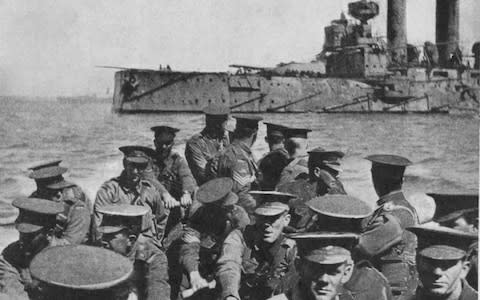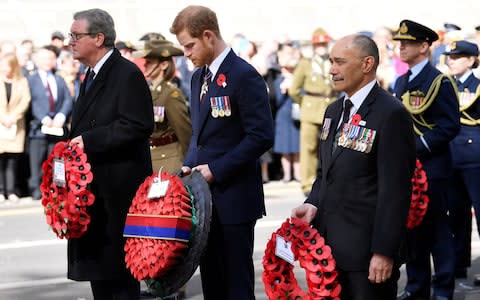Anzac Day 2019: How the Gallipoli battle helped forge Australia and New Zealand's national identities

Anzac Day, the national day of remembrance in Australia and New Zealand, is set to take place at the end of this month, with events in honour of those who served in war to be held across the globe.
Recognised annually on April 25, the day marks the anniversary of the first significant military action fought by Australian and New Zealand soldiers during the First World War.
On this date in 1915, the troops, who quickly became known as the Anzacs, landed in Turkey, joining the allied expedition that planned to capture the Gallipoli peninsula.
Since the date was officially named Anzac Day in 1916, remembrance services have taken place to celebrate the bravery of those who fought in Gallipoli, with memorial events now held to honour all those who served and died in conflicts.
From the history of events that took place on April 25 to today's worldwide commemorations, here is the story of Anzac Day.
What does 'Anzac' stand for?
The term 'Anzac' stands for Australian and New Zealand Army Corps. The group of soldiers formed in Egypt, in December 1914 and were commanded by General William Birdwood, comprising of troops from the First Australian Imperial Force and First New Zealand Expeditionary Force.
The Anzacs are most well known for operating in the Battle of Gallipoli in 1915, but they also briefly reestablished in 1941, serving in the Battle of Greece during the Second World War.

The Gallipoli campaign
On April 25, 1915, the Anzacs joined the British Empire and French troops at Gallipoli, Turkey, landing at what is now known as Anzac Cove.
As well as their plans to capture the Gallipoli peninsula and open the Dardanelles to the allied navies, the troops set out to capture Constantinople, the capital of the Ottoman Empire - which is now known as Istanbul.
Upon arrival, the Anzacs were met with the Ottoman Turkish defenders and faced a challenging battle in the subsequent eight months.
By the end of 1915, the military objectives were not successfully met and more than 8,000 Australian soldiers had been killed.

The impact and significance of Anzac Day
While the eight month campaign resulted in tragedy and the troops failed to capture the Gallipoli peninsula, the sacrifices the Anzacs made left a profound effect on those back home and became a source of national pride in Australia and New Zealand.
The "Anzac legend" soon forged a significant part of both countries' identities and in 1916, the first commemorations were held on April 25, with several ceremonies across Australia, a sports day in the Australian camp in Egypt and a march attended by 2,000 Australian and New Zealand troops in London.
Patriotic parades continued to be held on April 25 throughout the following years and in 1923, Anzac Day was established as a public holiday in Australia. By 1927, every state held a form of commemoration.
In the 1930s, dawn vigils, memorial services and games of two-up became annual traditions to honour the Anzacs, many of which continue to play an important role in modern day commemorations.
In later years, April 25 evolved as a day to recognise the Australians and New Zealanders who died in the Second World War and since 1942, Anzac Day has been honoured at the Australian War Memorial.
Nowadays, Anzac Day is a national occasion to remember everyone who served and died in all wars and peacekeeping action.
Today's commemorations
As part of the commemorations, Anzac Day typically begins with memorial services held at dawn, to mark the soldiers' original time of landing in Gallipoli, Turkey.

Thought to have increased in Australia following the events of 1915, the dawn services were previously restricted to veterans and would tend to include a single bugler playing the 'Last Post', followed by two minutes of silence.
In recent years, families of veterans and members of the public have been welcomed to dawn services and the events now often include hymns, prayers and the recital of the 'For the Fallen' poem.
While they are held in both Australia and New Zealand annually on April 25, other countries around the world including France and the UK also hold their own dawn services.
Other ceremonies later take place at war memorials on the day, where wreaths are laid to reflect on those who fought and lost their lives.

Ex-servicemen and women also join city marches to remember those who served in conflicts while rosemary is traditionally worn on April 25, because it was found growing wild on the Gallipoli peninsula.
Two-up
Two-up is a gambling game originating from Australia, where two coins are tossed into the air and players make a bet on whether they will land on heads or tails.
It was often played by Australian troops throughout the First World War but its popularity later declined in the 1950s, due to other gambling developments such as poker machines.
Now Anzac Day is the only day of the year where people can legally play two-up in all Australian states, with games taking place in Returned Servicemen's League clubs.
Anzac biscuits
Anzac biscuits, a sweet treat made from rolled oats, were frequently sent to soldiers during the First World War.
Previously known as soldiers' biscuits, wives and women's groups would send them to troops abroad because they retained a high nutritional value and remained edible, without refrigeration, during transportation.
Anzac biscuits became a common part of the soldiers' diets in Gallipoli and today, they are one of the few commercial products legally produced using the term 'Anzac'.

 Yahoo News
Yahoo News 
